Common Faults and Solutions of Marine Valves
With today's science and technology, marine valves already have the advantages of high hardness, strong abrasion and corrosion resistance, long service life and so on. However, occasionally, there are some faults during use, which may have a significant impact on marine valves. And the following is a brief introduction about these faults and corresponding solutions.
1. The device does not operate, DCS reports timeout alarm
Failure analysis: a, the power does work;
b, lack of phase - the main loop;
c, the control loop does not work;
Solution: a, check the power supply and voltage of each circuit;
b, check if there is any breaking phenomena on the main circuit phase wiring;
c, check whether the on / off limit position or torque switch operation is normal, and if there is any chain protection in the DCS control process;
2. "Fault" alarmed immediately once the DCS operation instruction has been issued
Failure analysis: a, short circuit phenomenon on main loop, causing protection action of thermal relay or power switch tripping;
b, jamming of internal mechanical or valve body and lead to excessive torque protection action;
c, torque control mechanism of the electric apparatus itself is faulty or the torque setting value is too small;
Solution: a, check whether the power switch is tripped and the thermal relay has actions;
b, manual jigger to see whether the transmission mechanism is jammed;
c, check the torque setting value;
Through the above analysis, we will have a rough idea about these faults and corresponding solutions. There must be other faults of marine valves in the future use, but as long as we actively analyze these faults, appropriate solutions will finally be out.

Next: Selection of Butterfly Valve Caliber
Previous: Valve Selection Procedure